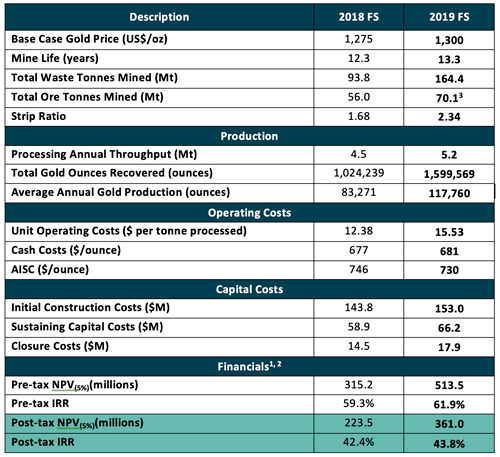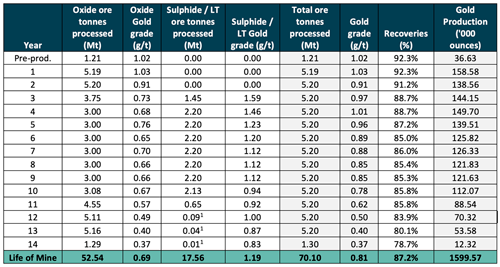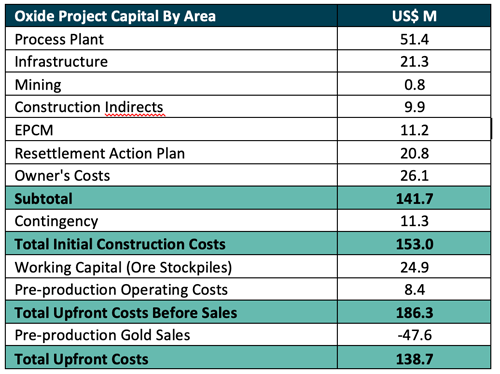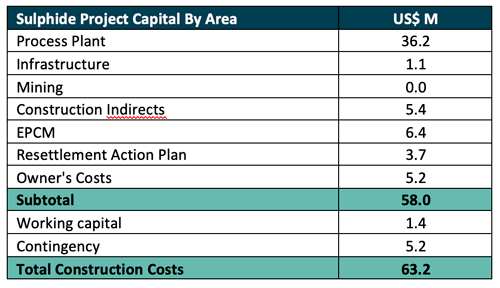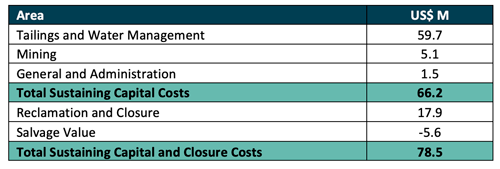LOM average annual gold production of 118koz, After-tax NPV5% of US$361M, IRR of 44% and LOM AISC of $730/oz
(All reported figures are in US dollars and are on a 100% project basis unless otherwise stated)
June 26, 2019 – Vancouver, BC - Orezone Gold Corporation (TSXV:ORE) ("Orezone" or the "Company") is pleased to report the results of its updated feasibility study (the "2019 FS") which incorporates a staged Phase II Sulphide Expansion for its 90%-owned Bomboré Gold Project in Burkina Faso, West Africa.
2019 FEASIBILITY STUDY HIGHLIGHTS (at Base Case gold price of $1,300/oz)
- Pre-tax NPV5% of $513.5M and IRR(1) of 61.9% with a 1.5-year payback
- After-tax NPV5% of $361.0M and IRR(1) of 43.8% with a 2.5-year payback
- Mine life of 13+ years with life-of-mine ("LOM") gold production of 1.6M ounces and average annual production of 133.8k ounces in the first 10 years
- Initial project construction costs estimated at $153.0M
- First gold pour targeted for June 2021
- LOM expansion capital costs of $63.2M
- LOM sustaining capital costs of $66.2M
- LOM cash costs of $681/oz with cash costs of $629/oz in the first 10 years
- LOM AISC(2) of $730/oz with AISC(2) of $672/oz in the first 10 years
Notes:
- IRR calculated from start of commercial production.
- AISC excludes Corporate G&A.
The 2019 FS incorporates a staged Phase II Sulphide Expansion with production commencing in Year 3 of oxide operations. This expansion, funded from oxide cashflows, significantly improves the overall gold production profile and project economics by processing 17.6Mt of higher-grade sulphide and lower-grade transition ("LT") ore. Furthermore, the addition of these Reserves and the oxides within the "Restricted Zones" facilitates the increase in the annual plant throughput from 4.5 million tonnes per annum ("Mtpa") in the 2018 FS to 5.2Mtpa in the 2019 FS.
"The staged development approach at Bomboré results in increased annual gold production, improves operating margins and significantly enhances economics including a material increase in after-tax NPV of $137.5M. The results of the 2019 FS confirm that Bomboré is a long-life, low-cost gold mine and we continue to evaluate additional project opportunities." said Patrick Downey, President and CEO. "Equally important, the decision to complete the Phase II Sulphide Expansion after the start-up of oxide operations, allows the Company to fund construction of the sulphide circuit without the need for additional upfront capital."
Lycopodium Minerals Canada Ltd. ("Lycopodium") of Toronto, Canada was the lead 2019 FS consultant (Process Engineering and Overall Study Manager), supported by Knight Piésold Consulting. of Denver, USA (Tailings and Water Storage Systems), AMC Consultants ("AMC") of Vancouver, Canada and Maidenhead, United Kingdom (Reserves and Mining), Roscoe Postle Associates Inc. ("RPA") of Toronto, Canada (Mineral Resources) and AnteaGroup®, France (Social & Environmental).
The Company will host a conference call and webcast on Thursday, June 27th at 10:30 am EDT to further discuss the Bomboré 2019 FS results. Details are provided at the end of this press release.
BASE CASE SUMMARY
Table 1 – Comparison of 2018 FS versus 2019 FS
Notes:
- Represents total project cash flows net of government royalties and taxes. The Government of Burkina Faso benefits from a 10% free-carried interest, sales royalties (4% NSR between $1,000 and $1,300 Au), Local Development Mining Fund tax (1% NSR), corporate income tax (27.5% tax rate), fuel taxes, VAT and withholding taxes on services.
- Exchange rate assumptions: XOF:USD = 550; USD:EURO = 1.19; XOF:EURO = 655.957; Fuel price delivered to site: Diesel = $1.05/litre; Heavy-Fuel Oil = $0.62/litre.
- Total ore Tonnes Mined and stated Mineral Reserves in Table 3 exclude 1.7M tonnes of mineralized low-grade material not in the current mill feed schedule.
The Phase I oxide operation is scheduled to commence commercial production in Q4-2021 after a 23-month construction period followed by 4 months of commissioning and ramp-up to commercial production. Construction of the Phase II Sulphide Expansion will start in 2023 with the introduction of sulphide feed in Q1-2024.
The sulphide circuit will be designed for a throughput of 2.2Mtpa and consists of a single stage jaw crusher, SAG mill, pre-leach thickener, a pre-oxidation tank and three leach tanks. After 24 hours of leaching, the sulphide material then combines with the oxide material in the existing Carbon in Leach ("CIL") circuit for final leaching and gold recovery. The combined oxide/sulphide throughput will remain at 5.2Mtpa. As previously disclosed, the sulphide circuit was originally contemplated to be 1.2Mpta but further optimization studies confirmed that the higher-grade LT and sulphide ore would support a 2.2Mtpa circuit.
MINERAL RESOURCE AND MINERAL RESERVE
RPA provided an updated Mineral Resource estimate with an effective date of January 5, 2017 ("2017 Mineral Resources") by incorporating the oxide material within the previously excluded "Restricted Zones" and all drilling completed to that date on the high-grade P17S deposit.
The Mineral Reserves estimate for the 2019 FS was prepared by AMC and is based on the 2017 Mineral Resources.
The Mineral Resource estimate comprises five separate block models which have been combined into a global resource as shown in Table 2 below.
Table 2 - Bomboré Mineral Resource Estimate, as of January 5, 2017
Notes:
- CIM definitions (2014) were followed for Mineral Resources.
- Mineral Resource are inclusive of Mineral Reserves.
- Oxide resources are made up of the regolith, saprolite and upper transition layers reported at a cut-off of 0.2 g/t Au.
- Sulphide resources are made up of lower transition and fresh layers reported at a cut-off of 0.2 g/t Au and 0.38 g/t Au respectively.
- Mineral Resources have been constrained within a preliminary pit shell generated in Whittle software.
- Mineral Resources are estimated using a long-term gold price of US$1,400 per ounce.
- A minimum mining width of approximately 3 m was used.
- Bulk densities vary by material type.
- Mineral Resources that are not Mineral Reserves do not have demonstrated economic viability.
- Numbers may not add due to rounding.
For the Mineral Reserve estimate, AMC developed new reserve block models, for each of the resource block models, by applying the modifying factors necessary for conversion of Mineral Resources to Mineral Reserves. Those factors included amongst others, weathering profiles, operating costs, mining dilution and extraction factors, and pit slope angles. Cut-off grade determinations for block assignments (ore versus waste) were based on a gold price of $1,250/oz.
Table 3 - Bomboré Mineral Reserve Estimate, June 26, 2019
Notes:
- Oxides include regolith, saprolite and upper transition material.
- Sulphides include lower transition and fresh material.
- Mineral Reserves have been estimated in accordance with the CIM Definition Standards.
- Mineral Reserves are estimated at an average long-term gold price of US$1,250/troy oz.
- Mineral Reserves are based on cut-off grades that range from 0.300 to 0.325 g/t Au for oxides, and 0.466 to 0.555 g/t Au for sulphides.
- Mineral Resources which are not Mineral Reserves do not have demonstrated economic viability.
- There are 1.7Mt of low-grade mineralized oxide material above cut-off grade remaining in the stockpiles that are not included in the Reserves Estimate.
- Mining recovery factors estimated at 98% for Oxides and 96%-100% for sulphides.
- Processing recovery varies by grade, weathering unit and location.
- Rounding of some figures may lead to minor discrepancies in totals.
MINE PLAN AND PRODUCTION SUMMARY
The 2019 FS mine plan is based on an annual feed rate to the plant of 5.2Mtpa of ore, delivering higher-grade ore in the early years of the project, by stockpiling of lower-grade material and subsequent drawdowns in the later years. The first 2.5 years of production will be free-dig oxide ore only. In year 3 the sulphide circuit will be commissioned and as it ramps up to 2.2Mtpa capacity, the throughput of the oxide circuit will be correspondingly reduced to 3.0Mtpa to maintain the combined capacity at 5.2Mtpa.
Oxide mine waste will be utilized as construction material for the tailings storage facility, thereby reducing water management costs and closure costs associated with waste dumps. The oxide ore is free-dig and is composed of over 70% passing 150 micron material that requires minimal grinding before leaching. The upper transition, although relatively soft, will require some grinding to achieve expected recoveries. The oxide ball mill is sized to handle a 70:30 oxide to upper transition blend.
The LT and sulphide ore, which require conventional drill and blast mining methods, will be mined using a separate equipment fleet to account for the increased density, abrasion and hardness
The calculated drill and blast pattern for the LT ore and waste are significantly lower than sulphide material with most of the LT material being minable through machine ripping.
Estimated gold production and diluted head grades for each year are summarized in the table below.
Table 4 - Summary Production Schedule
Note 1: LT and sulphide feeds will be crushed and processed through the oxide circuit, thereby eliminating the need to operate the sulphide SAG mill.
MINE PLAN
Oxides
Mining will be by a local contractor using a conventional diesel-hydraulic excavator fleet, and small 30t and 50t road type rear-dump trucks. Ore and waste are all "free-dig" material with little or no oversize material eliminating the need for drill and blast. This type of load and haul fleet is common in Burkina Faso and West Africa for similar free-dig material and will provide the needed versatility for a mine plan having a large number of shallow pits of varying tonnage.
Sulphides
Mining of the sulphides in the first three years of Phase II will incorporate the high grade P17S ore blended with higher-grade material from the other sulphide zones to maximize the value of the project. The schedule was developed to satisfy physical and practical constraints including a sustainable production profile, achievable vertical advance rates, practical use of low-grade stockpiling and minimizing mining of oxides and sulphides concurrently within the same pits. Mining of the LT and sulphides will be by contractor with trucks suited to the more abrasive and denser rock types. The LT requires a less dense drill hole pattern and lower powder factor than needed for sulphides.
MINERAL PROCESSING
Metallurgical testing has been ongoing on all ore types since 2008. The most recent testing on oxide material was completed by SGS in Quebec in Q4 2017 and included grinding and reagent optimization work. Testing on the LT and sulphide ores was completed in May 2019 by Base Metallurgical Laboratories located in Kelowna, British Columbia. Testing was performed on a series of composite and variability samples from the various pits. Test work included determination of grinding and abrasion parameters and the effect of grind size, cyanide addition, pre-aeration and leach time on gold extraction. Results also included settling tests and tailings and waste rock characterization test work.
Lycopodium has reviewed the historical and recent test data and based the process flowsheet on this work.
Oxides
The flowsheet and plant have been designed to process the soft fine-grained ore which eliminated the need for a crushing plant ahead of the grinding circuit. The ore is direct dumped across a static grizzly into a large hopper and onto a variable speed apron feeder. From the apron feeder, the ore is transferred to a conveyor that feeds directly to a ball mill. The plant is designed with two ore transfer points and one conveyor, thereby minimizing issues associated with wet sticky ore in the rainy season. The ball mill is equipped with a variable speed drive sized to accommodate a wide range of ore types and hardness.
Ball mill discharge is pumped to a cyclone cluster with the oversize reporting back to the mill and the undersize fed to a pre-leach tank and seven-stage CIL circuit. The CIL tails are thickened to recover process water and then pumped to a lined tailings facility. The tailings facility is designed to be zero discharge, with water recovered in a decant tower and returned to the process water tank at the plant. Gold is recovered in a standard 10t carbon desorption plant, finishing with electrowinning and smelting to produce gold doré bars.
Sulphides
The comminution circuit will consist of a primary jaw crusher followed by a SAG mill in closed circuit with hydrocyclones and a recirculation pebble conveyor system. A surge ore bin and dead ore stockpile are included in the design to provide surge capacity between the crushing and grinding stages. The cyclone overflow will be thickened and transferred to the pre-oxidation and leaching circuit. After 24 hours leaching, the leached sulphide product will be combined with the oxide mill product and fed to the CIL circuit for an additional 24 hours of residence time and gold recovery onto carbon.
ADR Plant Expansion
The 2018 FS was designed with a 5t carbon elution circuit for gold recovery. Additional test work completed in 2019 indicated that this plant was undersized and a new 10t elution circuit has been incorporated in the 2019 FS. This will allow carbon stripping to be completed on a more systematic basis and provide capacity for further expansion.
Optimization of the Tailing Storage Facility
The 2018 FS was based on a tailings storage facility footprint that was restricted by the location of low-grade ore stockpiles. During the Front-End Engineering and Design (FEED), this design was optimized, which eliminated these stockpiles allowing for an expanded TSF footprint. This has reduced tailings embankment construction quantities through the LOM, reducing both up-front capital and ongoing sustaining capital.
PROJECT INFRASTRUCTURE
The project benefits from a mining-friendly jurisdiction, a strong mining culture, and excellent local infrastructure. Burkina Faso has experienced rapid development of its mining sector over the past decade which has contributed to the growth of available mining contractors, suppliers, and skilled labour. In addition, the project is favourably situated only 85 kilometres from the capital city of Ouagadougou, accessed by a 5 kilometre all weather gravel road connecting to the main sealed highway (RN4) that runs between the capital and the coast. The Company has already seen the benefit of this in certain early works contracts where mobilization costs have been significantly lower than anticipated.
Offices and Accommodation
Orezone has constructed a main camp, kitchen and office complex including warehousing, sample preparation facility and small vehicle repair shop. The facility was upgraded in 2018/19 including new accommodation blocks for senior staff, upgrades to the kitchen and dining facility and certain new offices for technical staff. A contractor will continue to be responsible for all camp operations including catering, cleaning and maintenance activities. All communication systems, including internet, are in place.
Power Supply
A heavy-fuel oil ("HFO") power station will be constructed at the process plant by an independent power provider ("IPP") under a build-own-operate agreement. The power station will be fitted with 7 x 1.6 MW heavy duty HFO generator engines (or similar) with five operating and two standby units.
In year 2 of oxide operations, additional larger HFO units will be installed by the IPP as part of the sulphide expansion.
Aerial transmission lines of 11 kV will be constructed from the power station to the tailings storage facility, water storage facility, camp, and the mining contractor's area.
The power station will utilize a dedicated bulk HFO storage facility located adjacent to the powerhouse.
Water Supply
Raw water will be sourced from the seasonal Nobsin River and diverted by a permanent weir into an off-channel reservoir ("OCR"). The OCR is essentially one of the mine pits excavated early and designed to hold sufficient water for the project on an annual basis.
Pumps will transfer water from the OCR to the raw and process water tanks by pipeline.
Project Economics
OPERATING COSTS
Table 5 - Operating Cost Summary
Notes:
- AISC excludes corporate G&A expenses.
- Numbers may not add up due to rounding.
Mining costs are based on a detailed annual mining schedule incorporating the actual haul distances and pit depths as per contractor quotes. Processing costs are LOM averages and include various annual blends of oxide, transition and sulphide ores as mill feed, incorporating the various associated reagent consumptions, work indices, abrasion indices and power requirements.
INITIAL AND EXPANSION PROJECT CAPITAL COSTS
Since the release of the 2018 FS significant work has been completed to de-risk the project. FEED for the Phase I oxide facility is complete which has more accurately defined material quantities and detailed firm quotes have also been obtained for all major equipment. The camp and early stage civil works are complete and the Phase I Resettlement Action Plan ("RAP") construction is in progress.
Outside of the firm quotes received to date the remaining capital estimates are based on quotes including taxes and freight received up to the end of May 2019 from potential equipment and service providers. Other key aspects of the capital cost estimate include:
- Pre-production capital costs include the construction of the OCR and completion of remaining Phase I and II RAP activities prior to commencement of oxide mining
- Construction of the Phase II Sulphide Expansion commences in Year 2 of oxide operations
- The bulk earthworks for the sulphides will have already been completed during the oxide stage simplifying construction of the expansion
- Additional HFO power generation units will be added as necessary by the IPP
- A small focussed owner's team will be dedicated to overseeing construction and commissioning of the sulphide expansion.
Table 6 - Initial Capital for the Oxide Project
Notes:
- Numbers may not add up due to rounding.
- Excludes $5.1M used for early construction activities including Phase I RAP up to June 30,2019.
Table 7 - Expansion Capital for the Sulphide Circuit
SUSTAINING CAPITAL COSTS
Sustaining capital costs include ongoing tailings storage facility construction including liner, piping and valves and decant tower raises, second stage tailings pumps and motors. Also included in sustaining capital are haul road extensions, mine dewatering pumps and piping, surface water management pumps and piping, and replacement of surface support fleet on an ongoing scheduled basis.
Closure costs include all necessary remediation work required to return the site to meet all conditions of the Environmental Social Impact Assessment ("ESIA") thereby reducing the risks for health and safety, controlling erosion and developing a profile compatible with the future uses of the site.
Table 8 - Sustaining Capital & Closure Costs
PROJECT SENSITIVITIES
The project is sensitive to gold price as demonstrated in the following table:
Table 9 - Project Gold Price Sensitivity
Permitting
An update to the ESIA is underway to include the sulphide circuit, the "Restricted Zones" and to expand the mining license to include P17S. The Company expects to submit the updated ESIA in Q3 2019 and approval is expected in early 2020.
The Phase I Oxide portion of the project is fully permitted and ready for construction and operation with the exception of the "Restricted Zones" which is expected in early 2020. All necessary environmental baseline studies were completed prior to submission of the Mining Permit application in 2015. The Mining Permit was granted on December 30, 2016 and remains in full force and effect.
DEVELOPMENT UPDATE AND NEXT STEPS
The Phase 1 RAP house construction is currently underway and is expected to be completed in Q4 2019. With the Phase I oxides FEED completed, detailed engineering and procurement will commence in Q4 2019.
Orezone is working with Cutfield Freeman on its project financing initiatives and expects to progress financial discussions through 2019.
The estimated time to construct the Bomboré oxide process plant (pre-production) is 23 months, including time to excavate the OCR, complete the Phase 1 RAP, and a four-month commissioning and ramp up of the process plant. The critical path items are the Phase I RAP and OCR excavation. Timely completion of the Phase 1 RAP will allow commencement of the OCR excavation which will meet the water needs for commissioning, start-up and subsequent operations as the OCR is filled during the rainy season each year from May through October.
Construction of the sulphide expansion will commence in the second full year of oxide operations with construction estimated to take 12 months. The critical path for this expansion will be delivery and installation of the large SAG mill and motors.
PROJECT OPPORTUNITIES
Many of the enhancement opportunities identified in the 2018 FS have been included in the 2019 FS. As part of the 2019 FS work, several additional opportunities have been identified:
- Geological Interpretation: Refine the geological model to incorporate the knowledge gained from drilling at P17S and evaluation of potential for higher-grade oxides and sulphides at depth along plunge:
- Drilling undertaken during 2017 and 2018 was very successful in continuing to intercept significantly higher-grade oxide mineralization
- To date these results have NOT been incorporated in the resources or reserves
- Modelling of these zones is ongoing, and it is expected that this will be complete by end of 2019
- Limited deeper drilling has intercepted these higher-grade mineralized trends in sulphides along the same plunge zones which may provide underground targets for future exploitation.
- Metallurgical Recoveries: The most recent sulphide test work program resulted in better than historic test work recoveries. The 2019 FS has NOT included these improved recoveries and further test work is now planned, including the addition of oxygen sparging to the sulphide pre-leach to better quantify these higher recoveries.
- Dilution and Grade Control: Ongoing grade control and test mining work at site for the oxide material to determine if the mining dilution factors in the 2019 FS can be reduced which may improve mill feed grade.
- Regional Exploration: Regional exploration drilling in 2017 and 2018 continued to intercept oxide mineralization in several identified zones outside of the current mining lease, but within the exploration leases. Further exploration is warranted in these areas to determine if there is potential to add additional near surface oxide material and thereby extend mine operating life.
TECHNICAL REPORT FILING
The National Instrument 43-101 technical report supporting the 2019 FS and this press release will be filed on SEDAR within the next 45 days of the date of this press release.
QUALIFIED PERSONS
The independent Qualified Persons responsible for the FS, on which the NI 43-101 technical report will be based, are Manochehr Oliazadeh, P. Eng. of Lycopodium Minerals Canada Ltd.; Alan Turner CEng MIMMM of AMC Consultants; Tom Kerr, M.Sc, of Knight Piésold; David Ramel, P.Eng., of AnteaGroup®, France; and José Texidor Carlsson, P.Geo., M.Sc., and Tudorel Ciuculescu, P.Geo., M.Sc. of RPA. Each Qualified Person has reviewed and approved the scientific and technical information in this news release relevant to the portion of the 2019 FS for which they are responsible as set out below.
Manochehr Oliazadeh, P. Eng., of Lycopodium Minerals Canada Ltd. is responsible for the metallurgy, recovery methods, site infrastructure project implementation plan, and their associated capital cost and operating cost estimates, and the overall preparation of the consolidated capital and operating cost estimates and the report.
Alan Turner, CEng MIMMM., of AMC Consultants is responsible for the mining and Mineral Reserve estimates and the mine capital and operating costs.
Tom Kerr, M.Sc, of Knight Piésold and Co. is responsible for the tailings storage facility and site water management systems and the associated earthworks and civil construction quantities.
David Ramel, P.Eng., of AnteaGroup®, France, is responsible for Social and Environmental matters.
José Texidor Carlsson, P.Geo., M.Sc., and Tudorel Ciuculescu, P.Geo., M.Sc. of RPA are responsible for the Mineral Resource estimates.
Pascal Marquis, Geo., Ph.D., SVP and Patrick Downey, P. Eng., CEO of Orezone, are Qualified Persons under NI 43-101 and have reviewed and approved other scientific and technical information contained in this news release for which the independent Qualified Persons who prepared the FS are not responsible. Messrs. Marquis and Downey are not independent within the meaning of NI 43-101.
CONFERENCE CALL AND WEBCAST
The Company will host a conference call and webcast on Thursday, June 27th starting at 10:30 am EDT to further discuss the Bomboré 2019 FS results. To participate, please use the following dial-in phone numbers or join the webcast using the link below:
- U.S. & Canada Toll-Free: 1-800-319-4610
- Other International Toll-Free Number: +1-604-638-5340
- Webcast URL: http://services.choruscall.ca/links/orezonegold20190627.html
A copy of the presentation will be available on the Company's website.
Orezone Gold Corporation
Patrick Downey,
President and Chief Executive Officer
Vanessa Pickering
Manager, Investor Relations
Tel: 1 778 945 8977 / Toll Free: 1 888 673 0663
info@orezone.com / www.orezone.com
For further information please contact Orezone at +1 (778) 945-8977 or visit the Company's website at www.orezone.com.
Neither TSX Venture Exchange nor its Regulation Services Provider (as that term is defined in policies of the TSX Venture Exchange) accepts responsibility for the adequacy or accuracy of this release.
FORWARD-LOOKING INFORMATION AND FORWARD-LOOKING STATEMENTS:
This news release contains certain "forward-looking information" within the meaning of applicable Canadian securities laws. Forward-looking information and forward-looking statements (together, "forward-looking statements") are frequently characterized by words such as "plan", "expect", "project", "intend", "believe", "anticipate", "estimate", "potential", "possible" and other similar words, or statements that certain events or conditions "may", "will", "could", or "should" occur.
All of the results of the Bomboré Gold Project 2019 FS are forward-looking statements. These include statements regarding, among others, completion of the Phase I RAP in Q4-2019; approval of the updated ESIA by early 2020; first gold pour in June 2021; oxide commercial production starting in Q4-2021; sulphide feed commencing in Q1-2024; and applicable construction timelines. In addition, forward-looking statements include statements with respect to: pre-tax NPV5% of $513.5M and IRR(1) of 61.9% of with a 1.5 year payback (IRR calculated from start of commercial production); after-tax NPV5% of $361.0M and IRR of 43.8% with a 2.5 year payback; mine life of 13+ years with LOM gold production of 1.6M ounces and average annual production of 133.8k ounces in the first 10 years; initial project construction costs estimate at $153.0M; LOM expansion capital costs of $63.2M; LOM sustaining capital costs of $66.2M; and LOM cash costs of $681/oz with cash costs of $629/oz in the first 10 years; and LOM AISC of $730/oz with AISC of $672/oz in the first 10 years (AISC excludes Corporate G&A). Furthermore, statements regarding mine plan and production; mineral processing; project infrastructure; project economics; initial project capital costs; development and timeline timetables; and project opportunities are forward-looking statements.
All such forward-looking statements are based on certain assumptions and analyses made by management and qualified persons in light of their experience and perception of historical trends, current conditions and expected future developments, as well as other factors management and the qualified persons believe are appropriate in the circumstances. The forward-looking information and statements are also based on metal price assumptions, exchange rate assumptions, cash flow forecasts, and other assumptions used in the 2019 FS. Readers are cautioned that actual results may vary from those presented.
In addition, all forward-looking information and statements are subject to a variety of risks and uncertainties and other factors that could cause actual events or results to differ materially from those projected in the forward-looking statements including, but not limited to, use of assumptions that may not prove to be correct, unexpected changes in laws, rules or regulations, or their enforcement by applicable authorities; the failure of parties to contracts to perform as agreed; social or labour unrest; changes in commodity prices; unexpected failure or inadequacy of infrastructure, the possibility of project cost overruns or unanticipated costs and expenses, accidents and equipment breakdowns, political risk, unanticipated changes in key management personnel and general economic, market or business conditions, the failure of exploration programs, including drilling programs, to deliver anticipated results and the failure of ongoing and uncertainties relating to the availability and costs of financing needed in the future, and other factors described in the Company's most recent annual information form and management discussion and analysis filed on SEDAR on www.sedar.com. Readers are cautioned not to place undue reliance on forward-looking information or statements.
This news release also contains references to estimates of Mineral Resources and Mineral Reserves. The estimation of Mineral Resources is inherently uncertain and involves subjective judgments about many relevant factors. Mineral Resources that are not Mineral Reserves do not have demonstrated economic viability. The accuracy of any such estimates is a function of the quantity and quality of available data, and of the assumptions made and judgments used in engineering and geological interpretation, which may prove to be unreliable and depend, to a certain extent, upon the analysis of drilling results and statistical inferences that may ultimately prove to be inaccurate. Mineral Resource estimates may have to be re-estimated based on, among other things: (i) fluctuations in the price of gold; (ii) results of drilling; (iii) results of metallurgical testing, process and other studies; (iv) changes to proposed mine plans; (v) the evaluation of mine plans subsequent to the date of any estimates; and (vi) the possible failure to receive required permits, approvals and licenses.
Although the forward-looking statements contained in this news release are based upon what management of the Company believes are reasonable assumptions, the Company cannot assure investors that actual results will be consistent with these forward-looking statements. These forward-looking statements are made as of the date of this news release and are expressly qualified in their entirety by this cautionary statement. Subject to applicable securities laws, the Company does not assume any obligation to update or revise the forward-looking statements contained herein to reflect events or circumstances occurring after the date of this news release.
Neither TSX Venture Exchange nor its Regulation Services Provider (as that term is defined in policies of the TSX Venture Exchange) accepts responsibility for the adequacy or accuracy of this release.


